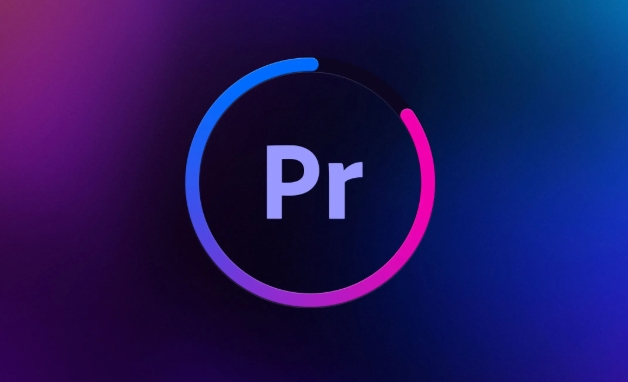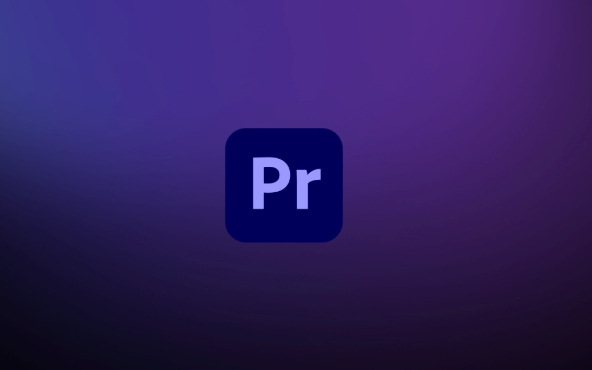The key to editing 360 videos in Premiere Pro is to preserve spatial orientation information and correctly set VR properties. 1. After importing, right-click the material and select "Set as VR material" or specify an isometric columnar projection format in the sequence settings; 2. Use the VR viewing angle tool to adjust the default viewing direction to ensure visual consistency; 3. Avoid fast mirror cutting and strong directional transitions during editing, and place the subtitles in the center of the field of view; 4. Check "VR Video" when exporting, select the appropriate resolution and bit rate, and test the playback effect to ensure no deformation or black edge problems.

Editing 360 videos is not actually complicated in Premiere Pro, but you need to pay special attention to several key points. Unlike ordinary videos, 360 videos need to retain their spatial direction information, otherwise they may look "crooked" or have a confusing perspective after exporting. Below are some practical operation suggestions to help you successfully complete 360 video editing.

Set the project to 360/VR video format
After importing 360 videos at the beginning, you must first confirm whether Premiere is recognized as VR content. If not set correctly, 360 effects may be lost during subsequent exports.

- Right-click on the material on the timeline → select " Set as VR (Virtual Reality) Material "
- Or manually specify the projection format in " Sequence Settings ", such as " equilictangular "
The common 360 videos are 3840x1920 resolution, which is a 2:1 aspect ratio. If the ratio is incorrect, it may be that ordinary videos are mistaken for VR content. Remember to check it clearly.
Use the VR Perspective Tool to adjust the viewing direction
During the editing process, you may need to adjust the direction the audience sees by default, such as letting the focus appear directly in front of the screen.

- Click the " VR View Control " button (a small earth icon) in the upper right corner of "Program Monitor"
- After entering VR view, you can drag the screen to adjust the default viewing angle.
- You can also use a gyroscope to control the rotation angle to simulate the effect of the user's head rotation.
This feature is ideal for maintaining visual coherence when transitioning or switching lenses, avoiding the audience's sudden "difficult".
Editing Notes and Frequently Asked Questions
360 videos cannot be cut into mirrors randomly like ordinary videos, because continuity of perspective is important. Pay special attention to the following points:
- Do not use quick editing or frequent jump cuts : it will make the audience feel confused
- Use the transition effect with caution : it is recommended to use fade in and out instead of highly directional transitions such as sliding and page turning.
- Subtitles and graphics should be placed in the center of the field of view : avoid appearing on the top of the head or the soles of the feet, otherwise it will be difficult for the audience to notice.
If you have multiple layers overlayed on the timeline, remember to check if they have VR properties set as well, otherwise it may cause synthesis errors.
Key settings for exporting 360 videos
The most critical point before exporting is to make sure the metadata is written correctly so that the platform (such as YouTube or VeeR) can recognize that this is 360 videos.
- When exporting media, check " VR Video " under " Basic Settings "
- The projection format is generally selected as " isometric columnar projection ".
- The resolution is recommended to be at least 1080p or above. The higher the code rate, the clearer the image quality.
After the export is completed, you can use a local VR player to test it to see if it is normal to go up, down, left and right, and whether there are any problems with black edges or deformation.
Basically these steps. Although it seems a bit detailed, you can successfully edit the 360 video by following the process.
The above is the detailed content of how to edit 360 video in Premiere Pro. For more information, please follow other related articles on the PHP Chinese website!

Hot AI Tools

Undress AI Tool
Undress images for free

Undresser.AI Undress
AI-powered app for creating realistic nude photos

AI Clothes Remover
Online AI tool for removing clothes from photos.

Clothoff.io
AI clothes remover

Video Face Swap
Swap faces in any video effortlessly with our completely free AI face swap tool!

Hot Article

Hot Tools

Notepad++7.3.1
Easy-to-use and free code editor

SublimeText3 Chinese version
Chinese version, very easy to use

Zend Studio 13.0.1
Powerful PHP integrated development environment

Dreamweaver CS6
Visual web development tools

SublimeText3 Mac version
God-level code editing software (SublimeText3)
 how to make text appear one letter at a time in Premiere Pro
Jul 08, 2025 am 12:02 AM
how to make text appear one letter at a time in Premiere Pro
Jul 08, 2025 am 12:02 AM
To display text letter by letter, use PremierePro’s built-in “Typewriter” animation preset or manually adjust the opacity or zoom of each character. 1. Use presets such as "Typewriter-Reveal" in the "EssentialGraphics" panel to directly apply the verbatim effect; 2. Enable character-by-character animation through the "EssentialGraphics panel" and select Opacity or Scale for customization; 3. Set Start and EndOffset to control the animation rhythm and combine keyframes to achieve dynamic changes; 4. You can adjust the offset, add blur or color change to enhance the effect. It is recommended that each letter lasts 0.1-0.2 seconds and is suitable for phrases rather than long paragraphs.
 how to fix red frames in Premiere Pro
Jul 07, 2025 am 12:16 AM
how to fix red frames in Premiere Pro
Jul 07, 2025 am 12:16 AM
The red box appears in PremierePro because the preview file is not generated or the material path is incorrect. Common reasons include just imported projects, material path changes, insufficient cache space, or failed proxy files loading. Solution: 1. Wait for automatic cache generation; 2. Manually generate preview rendering timeline; 3. Check and relink missing materials; 4. Clean and rebuild media cache. When using proxy clips, you should confirm that the proxy files are correctly associated and appropriately reduce the playback resolution to improve preview fluency.
 how to rotate video in Premiere Pro
Jul 04, 2025 am 01:33 AM
how to rotate video in Premiere Pro
Jul 04, 2025 am 01:33 AM
There are three ways to rotate videos in PremierePro. 1. Use the "Motion" option in the "Effect Control" to accurately adjust the rotation angle, which is suitable for fine operation; 2. Use the "Create Sequence from Clip" function to automatically correct the vertical video direction of the mobile phone, saving time and effort; 3. Use "Crop" and "Zoom" to adjust the screen to fill the screen and avoid black edges to ensure complete output quality.
 how to fade audio in Premiere Pro
Jul 05, 2025 am 12:50 AM
how to fade audio in Premiere Pro
Jul 05, 2025 am 12:50 AM
Adding a fade effect to audio in PremierePro can be achieved in three ways: 1. Use audio transition effects such as "Constant Gain" or "Exponential Fade" and drag directly to the beginning of the audio clip; 2. Manually add volume keyframes in the "Effect Controls" panel, and control fade speed and nature by adjusting the keyframe position and curve; 3. Use the "Trail Mixer" to drag the volume slider in real time to record the operation track, which is suitable for unified management of multi-track audio. Each method has its own advantages. Newbie can choose to quickly achieve the transition effect, advanced users are suitable for manual adjustment or use the track mixer to obtain more refined control. Finally, it is recommended that preview ensures that the audio transition is natural and smooth.
 how to apply an effect to multiple clips in Premiere Pro
Jul 05, 2025 am 12:22 AM
how to apply an effect to multiple clips in Premiere Pro
Jul 05, 2025 am 12:22 AM
There are three ways to quickly add the same effect to multiple clips in PremierePro: 1. Use the "EffectChainer" tool to first apply the effect to one clip, and then click other clips one by one through the chain icon in the effect panel to apply it in batches; 2. By copying and pasting attributes, right-click the first clip with added effects in the timeline to select copy, then select other clips to right-click to select paste attributes, and only select video or audio effects to paste; 3. Use the adjustment layer to process the video effect, create a new adjustment layer and place it above the target clip, and drag the effect to the adjustment layer to affect all clips below it. The above methods can significantly improve work efficiency and are suitable for the needs of different scenarios.
 how to normalize audio in Premiere Pro
Jul 04, 2025 am 12:16 AM
how to normalize audio in Premiere Pro
Jul 04, 2025 am 12:16 AM
NormalizingaudioinPremiereProadjuststheloudestpeakinacliptoatargetlevel,balancingvolumeacrossclips.1.Right-clickaclipandchoose“AudioGain…”2.Select“NormalizeMaxPeakto”andsetatargetlike-1dBor-3dB.3.ClickOKtoapply;thisscaleseachclip’svolumeuniformly.Itw
 how to create a cinematic look in Premiere Pro
Jul 06, 2025 am 12:07 AM
how to create a cinematic look in Premiere Pro
Jul 06, 2025 am 12:07 AM
To bring up a movie-like picture in PremierePro, the key is to adjust the basics and follow the following steps: 1. Use the LumetriColor panel for basic corrections and creative color grading to avoid directly applying presets; 2. Add FilmGrain effect to improve texture but not excessively; 3. Control the details of highlights and shadows, and combine local adjustments to enhance levels; 4. Set appropriate output parameters such as H.264 or ProRes, 10bit color depth to preserve the color grading effect.
 how to make a video look like old film in Premiere Pro
Jul 11, 2025 am 12:04 AM
how to make a video look like old film in Premiere Pro
Jul 11, 2025 am 12:04 AM
If you want the video to present the old movie effect in PremierePro, the core is to adjust color, add noise, simulate film scratches and adjust the frame rate appropriately. 1. Adjust the color style: Use the LumetriColor panel to reduce saturation, increase warm tones, or apply "antique" presets and fine-tune according to the picture; 2. Add particles and scratches: Add appropriate amount of particles through plug-ins or built-in effects, superimpose transparent scratch layers and select the appropriate blending mode; 3. Adjust frame rate and playback speed: Export high frame rate materials to lower frame rates or use frame fusion to simulate the playback rhythm of old movies; 4. Add black edges and slight jitter: Use a mask layer to add black edges, and retain slight shaking through WarpStabilizerVFX to enhance the sense of reality. Each step requires






